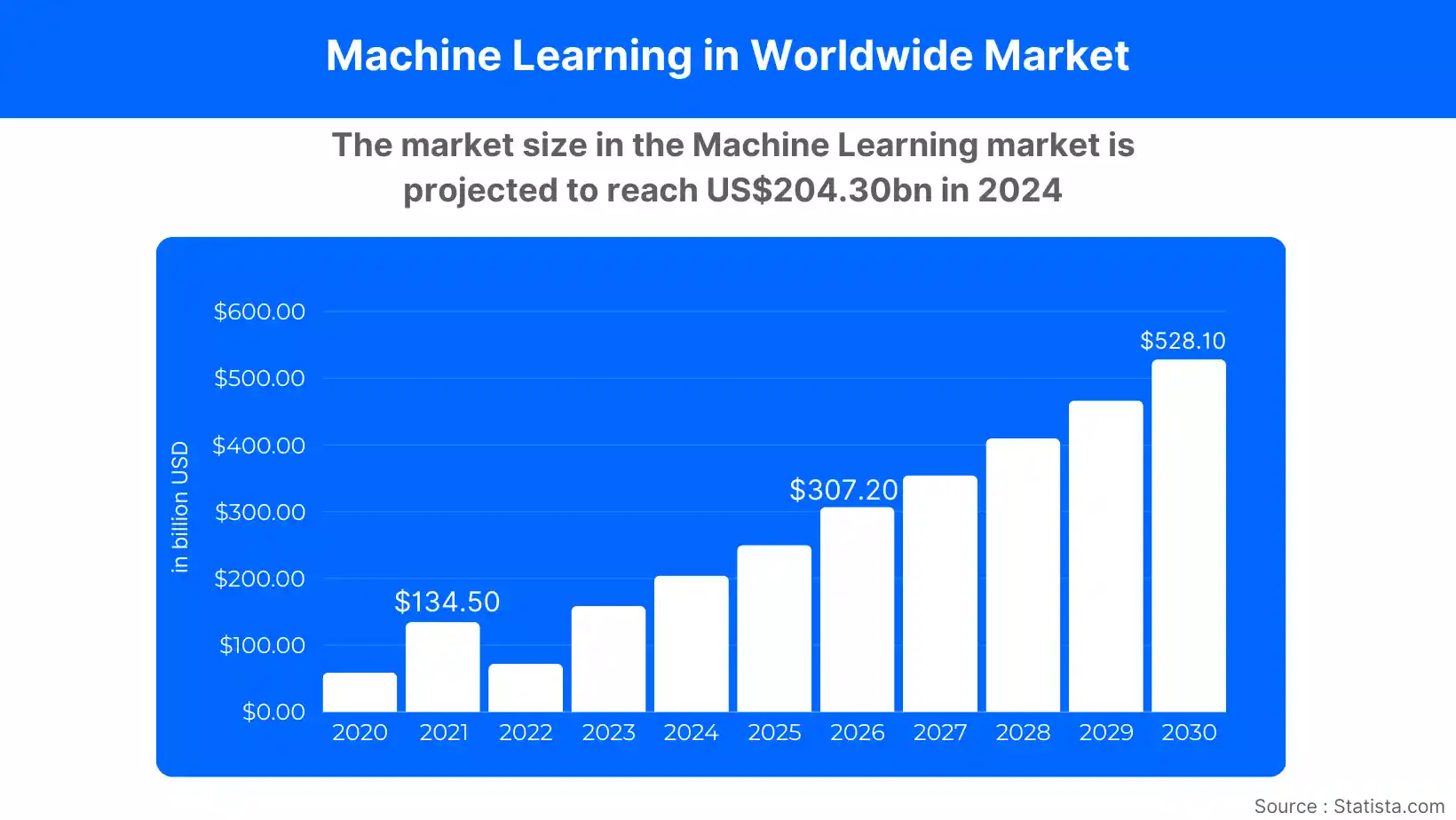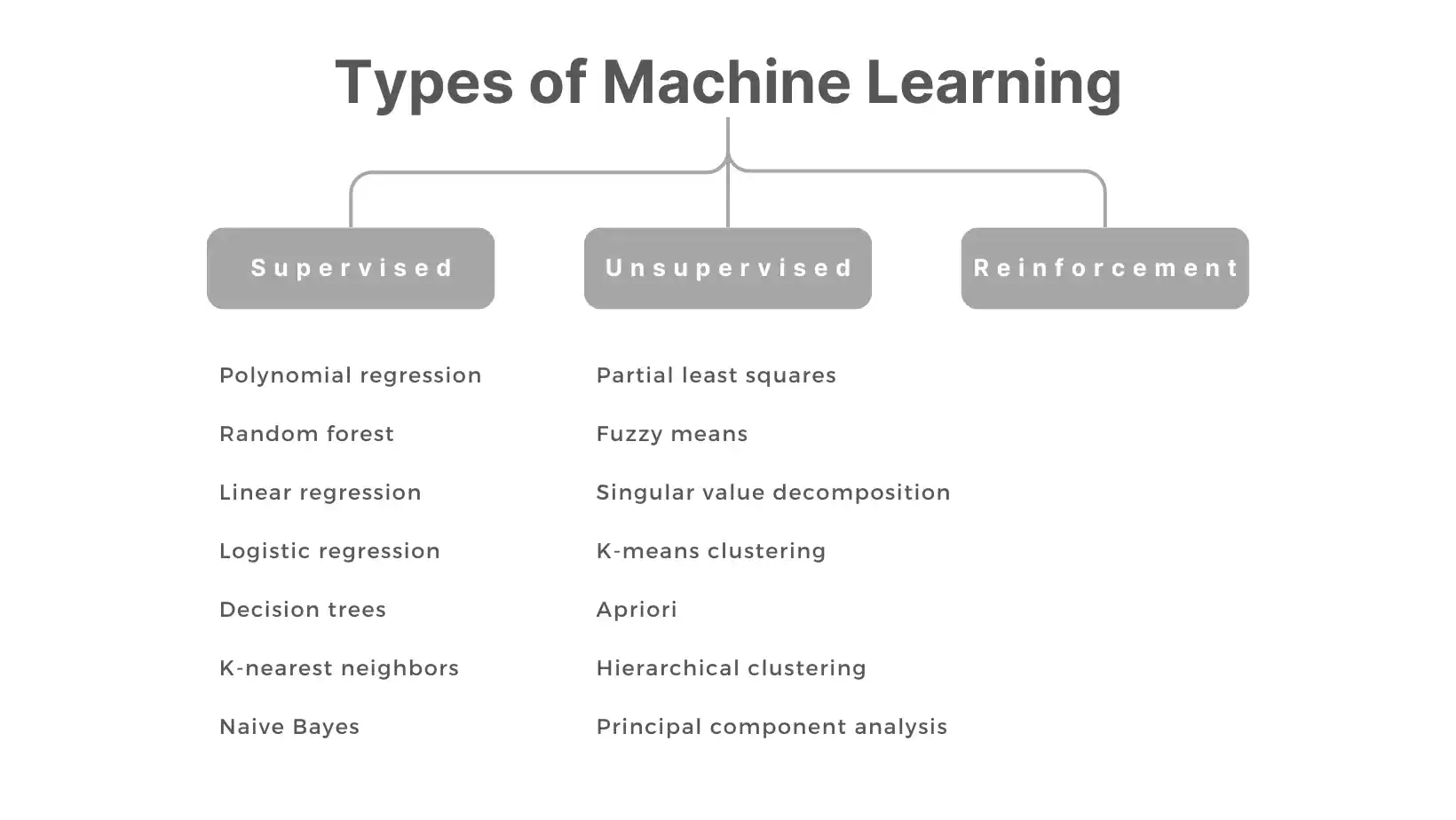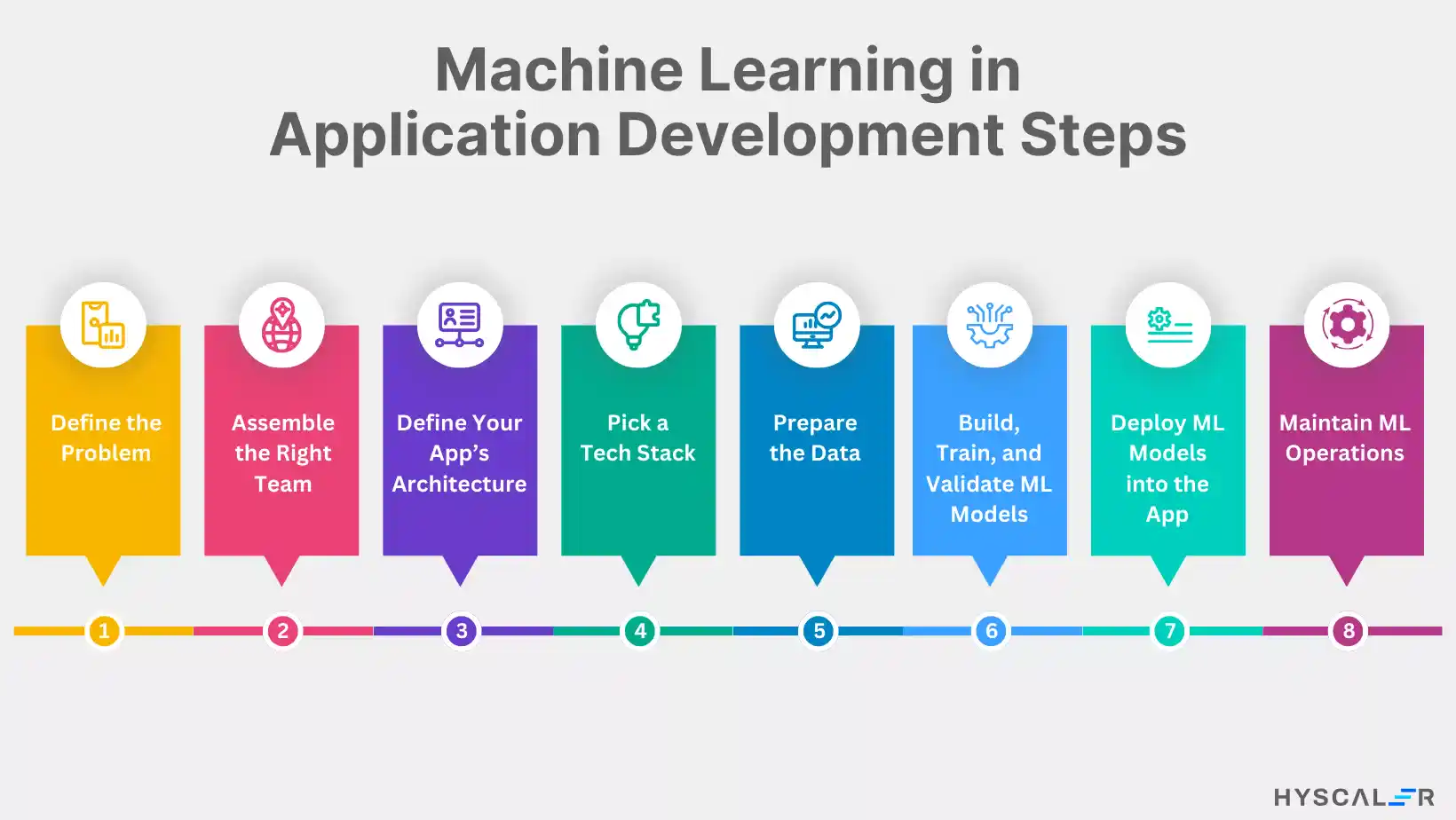Table of Contents
Machine Learning in Application Development
\Machine learning, a significant branch of artificial intelligence, is revolutionizing numerous sectors. It leverages algorithms that continually adapt to data, enabling computer systems to derive valuable insights. These insights range from identifying credit card fraud and optimizing manufacturing processes to predicting customer buying behaviors and understanding user online preferences.
The fascinating aspect of machine learning is its ability to enable computers to learn autonomously from previous experiences. It’s intriguing to observe a specialized data management system using near-real-time analytics to identify standard patterns and anomalies, compare current data with historical records, and summarize observed regularities.
Thanks to its exceptional accuracy, these predictions can facilitate intelligent actions without human intervention. In essence, machine learning app development has the potential to enhance the intelligence of mobile apps and streamline tasks without requiring specialized programming.
This blog aims to provide a comprehensive understanding of machine learning app development, its associated costs, and the factors that influence it. Besides exploring the process of building a machine learning app, we will also delve into an exclusive feature list that guarantees maximum ROI for the app.
What is Machine Learning?
Machine Learning (ML) is a specialized field within the AI ecosystem that focuses on constructing systems capable of learning and evolving through data analysis. This branch of science is closely intertwined with AI. ML enables AI-based apps to acquire knowledge from the data they gather and enhance their accuracy over time, all without the need for manual programming.
Machine learning algorithms are capable of recognizing patterns in large datasets, allowing them to make data-driven predictions and informed decisions. With each iteration, these algorithms become more adept at processing data, resulting in increasingly accurate predictions and choices.
Machine learning apps have been gaining traction in all industries worldwide for several years. The global machine learning market was valued at US $204.30 billion in 2024 and is predicted to grow at a CAGR of 17.15% by 2030, reaching US $528.10 billion. Given this, machine learning technology has the potential to become one of the most profitable investment areas.

One of the most significant benefits of machine learning is in mobile application development. The use of machine learning has become so widespread that you might not even realize that an app relies on it.
If you’ve ever wondered how to build a machine-learning app, this article will answer your question. Here’s what you will learn:
- What is machine learning?
- Machine Learning in Application Development
- Machine learning app examples
- Industries that can benefit from machine learning
- How to build a machine learning app
- Technology stack for machine learning app development
Let’s dive into the specifics of machine learning technology in software development. Machine learning is one of the subsections of science dedicated to the development and study of AI. It is focused on building systems that learn and evolve through data analysis. Machine learning (ML) is closely associated with Artificial Intelligence (AI). Machine learning allows AI-powered applications to learn from collected data and improve accuracy without manual programming.
Machine learning algorithms find patterns in massive amounts of data to make data-based predictions and decisions. This ability to learn from data and improve over time makes machine learning a powerful tool in the field of application development.
Machine Learning in Day-to-Day Life
Machine learning has become an integral part of our daily lives, revolutionizing various aspects of how we interact with technology and enhancing our experiences. Let’s explore some popular applications of machine learning in daily life:
Virtual Personal Assistants: Virtual assistants like Siri, Alexa, and Google Assistant leverage machine learning algorithms to understand and respond to user queries, providing personalized assistance.

Predictions while Commuting: Machine learning algorithms power commute estimation apps that analyze traffic patterns, historical data, and real-time information to predict travel times accurately.
Video Surveillance: Video surveillance systems equipped with machine learning capabilities can detect anomalies, recognize faces, and enhance security measures in public spaces and private properties.
Facial Recognition: Facial recognition technology utilizes machine learning algorithms to identify individuals in images or videos, offering applications in security systems, social media platforms, and authentication processes.
Recommendation Systems: Online platforms like Netflix, Amazon, and Spotify use machine learning to analyze user preferences and behavior, providing personalized recommendations for movies, products, and music.
Social Media Connections: Machine learning algorithms analyze user interactions and content preferences on social media platforms to suggest connections, recommend content, and enhance user engagement.
Image Recognition: Image recognition technology powered by machine learning enables applications like automatic tagging in photos, object detection in videos, and visual search capabilities in e-commerce platforms.
Natural Language Processing: Machine learning models for natural language processing are used in chatbots, language translation services, sentiment analysis tools, and voice recognition systems to facilitate communication and interaction.
Healthcare Diagnostics: Machine learning algorithms are employed in healthcare for medical image analysis, disease diagnosis, personalized treatment recommendations, and predictive analytics to improve patient outcomes.
These examples highlight the diverse applications of machine learning in our daily lives, showcasing how this technology continues to shape the way we interact with digital systems and services.
How Machine Learning Works? Understanding the Mechanisms of Machine Learning
Machine learning, a captivating facet of Artificial Intelligence, involves the process of learning from data with specific inputs to the machine. Delving into how machine learning operates is crucial for unlocking its potential applications in the future. The journey of machine learning commences by feeding training data into a chosen algorithm. This training data, whether known or unknown, plays a pivotal role in shaping the final machine-learning algorithm. The nature of the training data input significantly influences the algorithm’s functionality, a concept that will be further elucidated shortly.
Subsequently, new input data is introduced to the machine learning algorithm to assess its efficacy. The predictions generated are then juxtaposed against the actual results. In instances where discrepancies arise between predictions and outcomes, the algorithm undergoes multiple rounds of re-training until the desired results are achieved. This iterative process empowers the machine learning algorithm to autonomously learn and refine itself, progressively enhancing its accuracy over time. The subsequent section delves into an exploration of the three primary types and applications of machine learning.
Types of Machine Learning
Machine learning is multifaceted, delineated into two core domains: supervised and unsupervised. Each domain serves distinct purposes, leveraging various forms of data to yield outcomes. Supervised learning constitutes approximately 70% of machine learning endeavors, with unsupervised learning accounting for 10-20%, while reinforcement learning occupies the remaining percentage.

- Supervised Learning
Supervised learning entails utilizing known or labeled data for training purposes. Given the familiarity with the data, the learning process is guided or supervised toward successful execution. The input data traverses through the machine learning algorithm to train the model effectively. Once trained on known data, the model can seamlessly process unknown data and generate new responses.In a supervised learning scenario, consider a model discerning whether a given dataset represents an apple or another fruit. Once adequately trained, the model can accurately identify an apple within the dataset and provide the desired response.
Key algorithms prevalent in supervised learning include:
- Polynomial regression
- Random forest
- Linear regression
- Logistic regression
- Decision trees
- K-nearest neighbors
- Naive Bayes
- Unsupervised Learning
Unsupervised learning operates with unknown and unlabeled training data, devoid of prior human scrutiny. In this context, without predefined guidance from known data, the input is unguided within the algorithm – hence deriving its unsupervised nature. The machine learning algorithm processes this uncharted data to train the model in identifying patterns and generating responses autonomously. In an unsupervised setting, envision a scenario where unknown data comprises visually similar apples and pears. The trained model endeavors to cluster these items together based on similarities.
Prominent algorithms utilized in unsupervised learning encompass:
- Partial least squares
- Fuzzy means
- Singular value decomposition
- K-means clustering
- Apriori
- Hierarchical clustering
- Principal component analysis
- Reinforcement Learning
Diverging from conventional data analysis paradigms, reinforcement learning involves an iterative process of trial and error to discern actions yielding optimal rewards. This approach comprises three fundamental components: the agent (learner or decision-maker), the environment (comprising all agent interactions), and actions (executed by the agent). Reinforcement learning unfolds as agents select actions maximizing expected rewards over time. This optimization is most effective when agents operate within a structured policy framework conducive to decision-making processes.By unraveling these intricate facets of machine learning dynamics, individuals can gain profound insights into its operational mechanisms and diverse applications across various domains.
Top 10 Machine Learning Applications in 2024
Machine learning applications have permeated various sectors, driving innovation and efficiency. Machine learning in application development has brought greater advancement in ML applications. Here are some of the top applications of machine learning in 2024:
- Spam and Malware Filtering: Machine learning algorithms are instrumental in filtering out spam emails and detecting malware, enhancing cybersecurity measures.
- Social Media Features: Platforms like Facebook utilize machine learning to analyze user activities, interactions, and preferences to offer personalized friend suggestions and page recommendations.
- Product Recommendations: E-commerce platforms leverage machine learning algorithms to provide personalized product recommendations based on user behavior and preferences.
- Sentiment Analysis: Machine learning is employed for sentiment analysis, enabling businesses to gauge customer opinions, reviews, and feedback to make informed decisions.
- Automating Employee Access Control: Organizations utilize machine learning algorithms to automate and optimize employee access control based on job roles and responsibilities.
- Marine Wildlife Preservation: Machine learning plays a role in marine wildlife preservation efforts by analyzing data to monitor and protect endangered species.
- No-Code Machine Learning Platforms: The rise of no-code machine learning platforms democratizes AI access, making it easier for individuals without extensive coding knowledge to leverage machine learning capabilities.
- Healthcare Diagnostics: Machine learning algorithms are transforming healthcare diagnostics by analyzing medical images, predicting diseases, and personalizing treatment plans for patients.
- Predictive Maintenance: Industries like manufacturing use machine learning for predictive maintenance, forecasting equipment failures before they occur to minimize downtime and maintenance costs.
- Financial Fraud Detection: Machine learning is crucial in financial sectors for detecting fraudulent activities, analyzing transaction patterns, and enhancing security measures to prevent financial fraud.
Machine Learning in Application Development Steps: A Comprehensive Guide

Integrating machine learning capabilities into the realm of application development can revolutionize user experiences and unlock a myriad of opportunities. Here is a detailed step-by-step guide to help you harness the power of machine learning in application development:
- Define the Problem:
- The initial step in leveraging machine learning in application development is to clearly define the problem you aim to solve. This strategic approach ensures that machine learning algorithms are effectively utilized to address specific challenges within the app development process.
- Assemble the Right Team:
- Building a successful machine learning application requires assembling the right team. In addition to app developers, designers, and QA engineers, incorporating data analysts or data scientists into your team is essential for constructing and implementing machine learning models effectively.
- Define Your App’s Architecture:
- Establishing a robust architecture for your application is crucial to seamlessly integrate machine learning functionalities. Designing the app’s architecture with machine learning capabilities in mind ensures efficient data flow, user interaction, and backend systems that support the integration of machine learning models.
- Pick a Tech Stack:
- Selecting an appropriate tech stack tailored for developing a mobile app with machine learning capabilities is paramount. Choosing the right programming languages, frameworks, and tools enables you to build, train, and deploy machine learning models effectively within your application development process.
- Prepare the Data:
- Data preparation plays a critical role in leveraging machine learning in application development. Cleaning, transforming, and structuring data ensures that it is optimized for use by machine learning models, enhancing their accuracy and performance within the application.
- Build, Train, and Validate ML Models:
- Building and training machine learning models form the core of integrating machine learning into your application development process. Validating these models ensures their accuracy and reliability, empowering your application with intelligent functionalities driven by machine learning algorithms.
- Deploy ML Models into the App:
- Integrating trained machine learning models into your mobile application enhances its capabilities by enabling real-time predictions and decision-making based on data insights generated by the models. This integration elevates user experiences and engagement within the app.
- Maintain ML Operations:
- Continuous monitoring and optimization of machine learning models within your application are essential for sustained performance and relevance. By tracking accuracy, efficiency, and reliability over time, you can ensure that your application remains effective and competitive in the dynamic landscape of application development.
Partnering with a dedicated app development firm can streamline this process and help you capitalize on the vast potential of integrating machine learning in application development.
Industries Benefiting from Machine Learning in Application Development
The integration of machine learning in application development is revolutionizing various industries, enabling intelligent automation and data-driven decision-making. Here are some sectors that can leverage the power of machine learning in application development:
- Finance: Machine learning algorithms can revolutionize financial services by enhancing fraud detection, risk assessment, and providing personalized investment advice through innovative applications.
- Healthcare: The healthcare industry can harness machine learning in application development to improve patient outcomes with accurate diagnosis, personalized treatment plans, and efficient medical record management systems.
- Transportation: Machine learning applications in transportation can optimize systems by predicting traffic patterns, improving route planning, and enhancing safety measures for a more efficient and reliable transport network.
- Retail: Leveraging machine learning in application development enables retailers to offer personalized product recommendations, forecast demand accurately, and optimize supply chains for enhanced customer experiences and increased sales.
- Education: Machine learning applications can transform the education sector by personalizing learning experiences, providing adaptive assessments, and boosting student engagement through innovative educational apps.
- Insurance: The insurance industry benefits from machine learning in application development for streamlined risk assessment, efficient claims processing, and personalized insurance offerings tailored to individual needs.
- Cybersecurity: Machine learning applications enhance cybersecurity measures by enabling threat detection, intrusion prevention, and rapid incident response through advanced security-focused applications.
- Manufacturing: By integrating machine learning into application development, manufacturers can predict equipment failures, optimize production processes, and reduce waste for improved efficiency and productivity.
- Agriculture: Agriculture can benefit from machine learning applications in developing precision farming techniques, predicting crop yields accurately, and optimizing resource allocation for sustainable and profitable agricultural practices.
- Energy: Machine learning in application development aids the energy sector in demand forecasting, optimizing energy production processes, and improving energy distribution networks for enhanced efficiency and sustainability in energy systems.
These industries showcase the diverse applications of machine learning in application development, driving innovation, efficiency, and user experience enhancements across various sectors. As machine learning continues to evolve, its impact on industries will only grow more profound and transformative.
Exploring the Advantages of Machine Learning App Development for Your Business
- Enhanced Decision-Making:
- Machine learning empowers businesses to make informed decisions by analyzing vast amounts of data, extracting valuable insights, and predicting outcomes with a high degree of accuracy. This leads to more strategic and data-driven decision-making processes.
- Personalized Customer Experiences:
- By leveraging machine learning in app development, businesses can create personalized customer experiences through tailored recommendations, customized interactions, and targeted marketing campaigns. This level of personalization enhances customer satisfaction, fosters loyalty, and increases engagement.
- Predictive Analytics:
- Machine learning algorithms enable businesses to leverage predictive analytics, forecasting future trends, customer behavior patterns, and market dynamics. This predictive capability allows companies to anticipate changes, identify opportunities, and proactively adapt their strategies to stay ahead in a competitive market landscape.
- Efficient Marketing Campaigns:
- Machine learning algorithms analyze consumer behavior, preferences, and responses to marketing campaigns, enabling businesses to optimize their marketing efforts. By identifying the most effective strategies and targeting the right audience segments, companies can enhance the efficiency of their marketing campaigns and improve return on investment.
- Precise Sales Forecasts:
- Machine learning models can analyze historical sales data, market trends, and external factors to generate accurate sales forecasts. These forecasts help businesses make informed decisions regarding inventory management, resource allocation, and sales strategies, leading to improved operational efficiency and cost-effectiveness.
- Medical Diagnoses Support:
- In the healthcare sector, machine learning applications support medical professionals in making accurate diagnoses and treatment decisions by analyzing patient data, symptoms, and medical records. This technology enhances the precision of medical predictions, improves patient outcomes, and contributes to more effective healthcare delivery.
- Scalability and Efficiency:
- Machine learning applications automate repetitive tasks, optimize workflows, and adapt to changing business demands efficiently. This scalability and operational efficiency enable businesses to streamline processes, reduce manual intervention, and enhance overall productivity across various functions within the organization.
By embracing machine learning in app development, businesses can unlock a range of benefits that drive innovation, improve efficiency, and enhance competitiveness in today’s fast-paced business environment.
Technology Stack Used for Machine Learning App Development
Machine learning (ML) is transforming the landscape of application development by empowering applications with the ability to learn from data, adapt to changing environments, and make intelligent decisions. This technology has wide-ranging applications across various industries, from healthcare to finance, and is driving innovation in the development of intelligent and data-driven applications. When considering the technology stack for machine learning app development, several key components come into play:
- Programming Languages: Python and R are popular choices for ML development due to their extensive libraries and support for data manipulation and analysis.
- Frameworks: TensorFlow, PyTorch, and Keras are widely used ML frameworks that provide a structured environment for building and training ML models. These frameworks offer a range of tools and libraries for data preprocessing, model building, and evaluation.
- Data Processing Tools: Apache Spark, Apache Hadoop, and Apache Flink are used for processing large datasets and performing distributed computations. These tools enable efficient data processing and storage for ML applications.
- Cloud Platforms: AWS, Microsoft Azure, and Google Cloud Platform (GCP) provide scalable and cost-effective infrastructure for ML app development. These platforms offer a range of services for data storage, processing, and model deployment. To leverage these platforms effectively, especially Azure, it’s crucial to acquire a solid understanding of their functionalities and capabilities. Fortunately, valuable resources, such as Microsoft DP-203 Exam Dumps, are available that can help gain the necessary knowledge.
- No-Code/Low-Code Platforms: No-code and low-code ML platforms like DataRobot, H2O.ai, and Dataiku have gained prominence in recent years, democratizing access to AI and ML. These platforms enable non-technical users to build and deploy ML models without writing code.
- Continuous Integration and Deployment Tools: Jenkins, Travis CI, and CircleCI are used for automating the build, test, and deployment processes of ML applications. These tools ensure that the code is continuously tested and deployed, reducing the time to market for new features and updates.
By leveraging the right combination of these technologies, businesses can build powerful ML applications that drive innovation, improve efficiency, and enhance competitiveness in today’s dynamic business landscape.
FAQs
1. What industries can benefit from machine learning?
Machine learning has a profound impact across various industries, enhancing processes, decision-making, and customer experiences. Some industries that benefit significantly from machine learning include:
- Healthcare: Utilized for medical imaging analysis, personalized treatment plans, and predictive analytics for patient outcomes.
- E-commerce: Enhances customer experience through personalized recommendations, fraud detection, and inventory management optimization.
- Finance: Improves risk assessment, fraud detection, algorithmic trading, and customer service automation.
- Marketing: Enables targeted advertising, customer segmentation, sentiment analysis, and campaign optimization.
- Manufacturing: Enhances predictive maintenance, quality control, supply chain optimization, and demand forecasting.
2. What is the best technology to build a machine learning app?
The choice of technology stack for building a machine learning app depends on factors like the application’s requirements, scalability needs, and team expertise. Common technologies used in building machine learning apps include:
- Programming Languages: Python and R are popular for their extensive libraries and frameworks in the machine learning domain.
- Frameworks: TensorFlow, PyTorch, and scikit-learn are widely used for developing and deploying machine learning models.
- Cloud Platforms: AWS, Google Cloud Platform (GCP), and Microsoft Azure offer scalable infrastructure for hosting machine learning applications.
- Data Processing Tools: Apache Spark and Hadoop are used for processing large datasets efficiently.
3. What are some famous apps using machine learning?
Several well-known applications leverage machine learning to enhance user experiences and provide innovative solutions. Some famous apps using machine learning include:
- Amazon: Utilizes machine learning for personalized product recommendations and fraud detection in e-commerce transactions.
- Netflix: Employs machine learning algorithms to recommend personalized content to users based on viewing history.
- Google Maps: Integrates machine learning for real-time traffic predictions and route optimization.
- Facebook: Uses machine learning for content personalization, facial recognition in photos, and targeted advertising.
- Uber: Applies machine learning for dynamic pricing algorithms and ETA predictions based on traffic conditions.
These examples showcase how machine learning is integrated into various applications to improve efficiency, user engagement, and overall performance across different industries.
4. How can machine learning improve business operations?
Machine learning enhances business operations by optimizing processes, automating tasks, improving decision-making through data analysis, enabling predictive analytics for forecasting trends, and enhancing customer experiences through personalization and targeted marketing strategies.